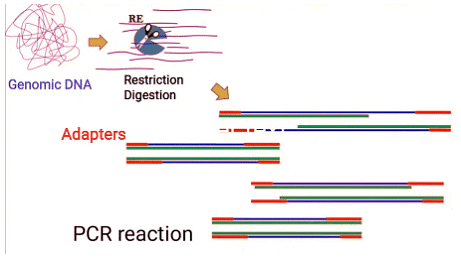AFLP | Zoology Optional Notes for UPSC PDF Download
| Table of contents |

|
| Introduction |

|
| Steps of AFLP |

|
| Applications |

|
| Advantages of AFLP marker |

|
| Disadvantages of AFLP |

|
| Summary |

|
Introduction
Markers are the tools that are used to distinguish DNA, individuals, populations or species. All the molecular marker techniques fall under two categories -
- The Restriction based
- PCR amplification based
The Example of restriction based technique is RFLP marker, In this technique the DNA is restricted with specific Restriction Endonucleases.
PCR-based markers include SSRs, RAPDs, ILPs etc.
In 1995 Peter Vos et al. developed a new marker type which is the combination of both the restriction based as well as the PCR based method. This marker type was named as AFLP or Amplified Fragment Length Polymorphism.
Principle of AFLP
- AFLP involves the digestion of genomic DNA using restriction endonucleuses, followed by adapter ligation and PCR amplification.
- The amplified products are visualised on high resolution polyacrylamide gels or automated sequencers. The variation in the length of fragments is analysed, which gives the estimate about genetic relationships among the individuals or the variations.
Steps of AFLP
Dna Extraction And Restriction Digestion
AFLP technique requires very good quality of intake and pure genomic DNA, which should be free from protein and contaminants.
The next step is the digestion with restriction endonucleuses. A rear cutter such as Eco R1 and a frequent cutter such as Mse-1 is used producing sticky ends.
- A rear cutter(Eco R1) identifies 6 base pair restriction site and cleaves it
- A frequent cutter(Mse-1) identifies and cleaves 4 base pair restriction site.

Ligation Of Oligonucleotide Adapters
Adapters are double-stranded short oligonucleotide sequences of usually 14 to 20 base pairs. Two different adapters are used one each for Eco R1 and another for Mse1.
These adapters of known sequences serves as the target for PCR amplification.
PCR Amplificationtion
- Amplification is done in two phases,
The first phase is known as pre-selective amplification and
The second phase is the selective amplification
(a) Pre-selective amplification
It is the first round of amplification, in which few fragments are selectively amplified.
A PCR reaction is set which contains
The genomic DNA,
- dNTPs
- Polymerase
- Eco R1 and Mse 1 restriction enzymes
- Primers with one additional nucleotide
PCR of 20 cycles is set using the PCR product of pre-selective amplification step.
(b) Selective Amplification
A second round of amplification is known as a selective amplification. In selective amplification more stringent primers (primer contain additional 3 nucleotides) are used to reduce the number of fragments amplified.
- Few cycles of Touchdown PCR is set to perform amplification.
- In touchdown pcr the annealing temperature is lowered by certain degrees after every PCR cycle to, improve the amplification efficiency of AFLP.
Separation And Analysis
- The separation of fragments can be done on a 6% polyacrylamide gel or automated sequencer containing pop gels. the bending pattern of the fragments is analysed manually or with analytical software.
- Separation and analysis is to be performed on sequencer in that case fluorescently labelled primers are used during selective amplification.
Applications
- To detect various polymorphisms in different genomic regions.
- For identification of genetic variation in strains or closely related species of plants, fungi, animals and bacteria.
- AFLP technique has been used in criminal and paternity tests to determine slight differences within populations and in linkage studies to generate maps for QTL(Quantitative trait locus) analysis.
Advantages of AFLP marker
- As restriction sites are present across the whole genome of an individual which makes AFLP marker to analyse multiple locus at once.
- The sequence information about the organism is not essential as the primers complementary to the adapter sequences are designed.
- In contrast to RFLP which takes longer time for probe hybridization and more skills, AFLP is comparatively simple as PCR amplification of fragments is done
- AFLP is possible with lesser amount of genomic template
- The results are highly reproducible considering have a high quality of DNA as input.
Disadvantages of AFLP
- AFLP cannot be done with poor quality of DNA or degraded DNA
- As AFLP are dominant markers in nature they cannot detect homozygous or heterozygous individuals.
- One cannot ascertain which fragment belongs to which dna locus as AFLP are multi-locus in nature.
Summary
- AFLP is a highly sensitive method for detecting polymorphism in DNA.
- AFLP is a dominant type of molecular marker, it involves restriction followed by PCR amplification of genomic DNA.
- Primers and adapters are used for pre-selective and selective PCR amplifications.
- Fragments can be analysed either on polyacrylamide gel or automated sequencers.
|
198 videos|351 docs
|
FAQs on AFLP - Zoology Optional Notes for UPSC
| 1. What is AFLP? |  |
| 2. What are the steps involved in AFLP? |  |
| 3. What are the applications of AFLP? |  |
| 4. What are the advantages of AFLP markers? |  |
| 5. What are the disadvantages of AFLP? |  |















